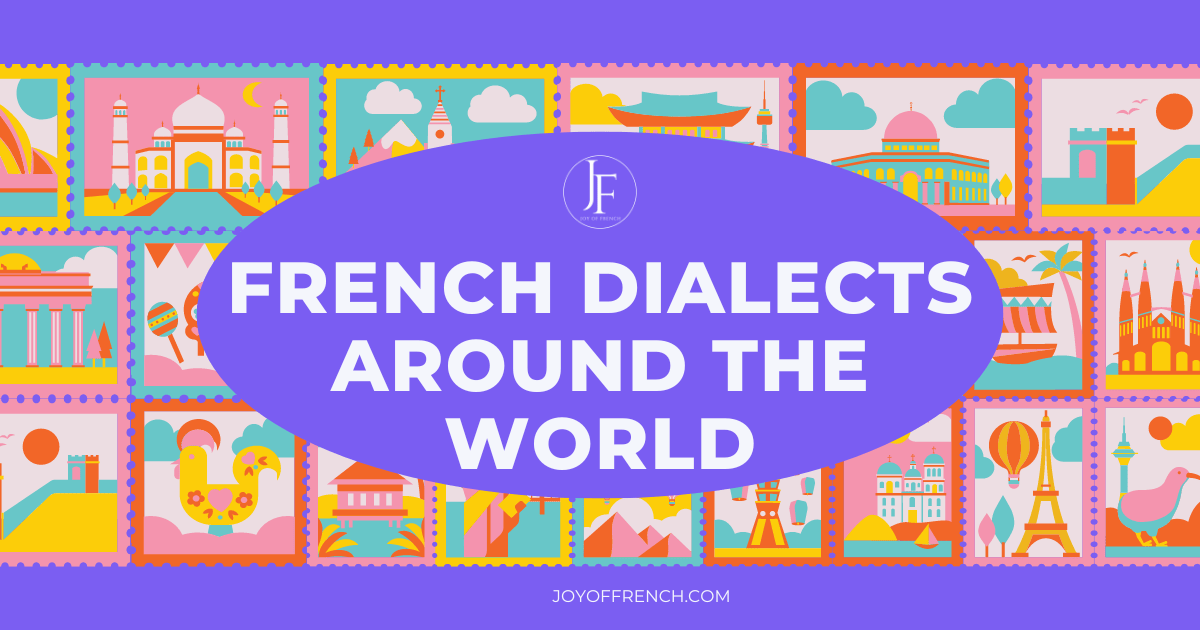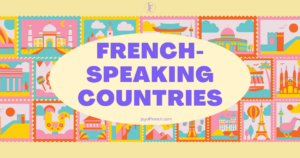Do you speak the French language? If so, which variant? French has many flavors, like Parisien, Swiss, Algerian, Marseillais, Québécois, Louisiana, and Haitian, to name a few.
It would be interesting to know which one you are referring to.
If you’re learning French, you will likely study “Standard French.” This is based on the language of Paris and not any regional French variety.
But what if you visit some other parts where French is spoken? You will need to understand what people are saying there, too. Plus, if your job demands French from that region.
French is a Romance language spoken by millions of people across the globe.
The 2022 OIF statement shows 321 million French speakers. Ethnologue reports the figure to be 309 million. With 29 French-speaking countries, it is one of the few languages with a presence in all five continents.
With a vast number of French language populations and nations where it is widespread, there are different regional variations and idioms of French.
Table of Contents
A Brief History of the French Language
The history of the French language is rich and complex. It spans over a millennium and is influenced by various linguistic, cultural, and historical factors.
The French language originates in Vulgar Latin. This was a spoken form of Latin used by common people in the Roman Empire. After the fall, Vulgar Latin evolved into various Romance languages, including old French.
From the 14th century, lots of standardization and codification happened. It then became the language of literature, culture, and administration in France, replacing Latin as the dominant language.
The “Dictionnaire de l’Académie française” publication in 1694 marked a milestone in standardizing French vocabulary and grammar.
French colonization in the 19th and 20th centuries led to the spread of French to other parts of the world—mainly Africa, Southeast Asia, and the Caribbean.
Due to the widespread of French worldwide, there are several varieties of French. This includes dialects, creoles, and even a distinct tongue closely related to standard French.
These dialects differ in grammatical structures, words, and levels of formality. Still, most speakers understand each other with little to no difficulty. But the accents can vary wildly between them.
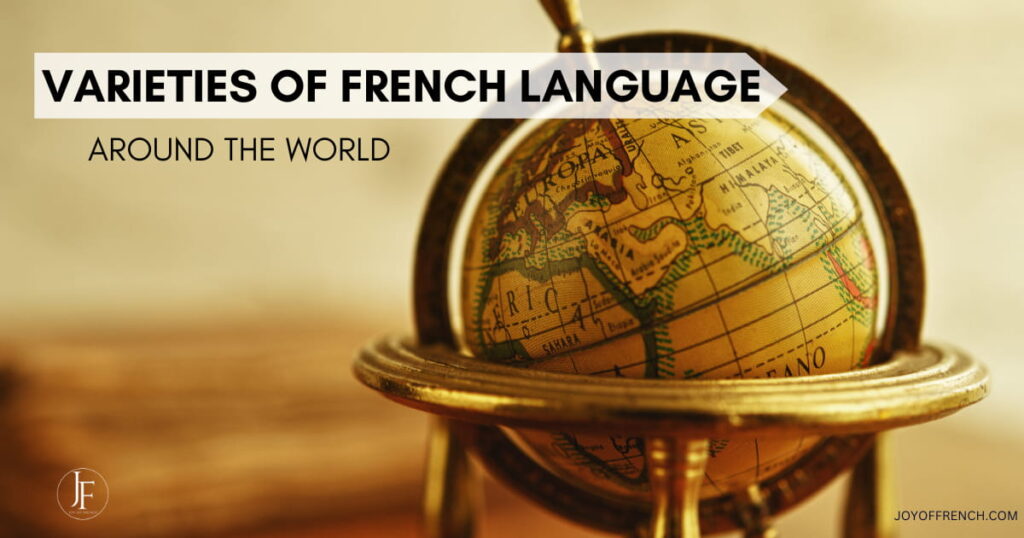
French varieties across the world
Like many other languages, French has several dialects. It varies depending on the region in which they are spoken and their history.
Most dialects have unique characteristics. This includes vocabulary, pronunciation, and grammar structure differences. The local culture and past leave their mark on each variety, making each unique and distinct.
Here are some notable dialects of French.
1. European French
There are many varieties of the French language in Europe.
(i) Standard French (Francien)
Standard French, Francien, or Metropolitan is the regulated French language version. This is useful across the board in France’s education, media, and official communication.
This variant is based on the pronunciation of the Île-de-France region, which includes Paris. Among all dialects, Parisian French is the most widely recognized.
An English speaker may not notice much difference between Parisian and other French dialects. But a native Parisian would quickly identify a distinct accent.
The Académie Française and other official institutions uphold this version of the language. Most learners typically learn this version when studying French.
Most official French tests follow the Francien. If you aim to take exams like DELF/DALF, TEF, and TCF, follow the standard version.
(ii) Marseillais
“Marseillais” is a distinct language and part of the maritime branch of “Provencal.” Still, it is viewed as a dialect spoken in the Marseille region and other parts of southern France for most purposes.
French speakers from Paris and Marseille can understand each other. Still, there are apparent differences in their speaking styles.
For instance, Marseillais speakers pronounce “e” at the end of words. In contrast, Parisian speakers often omit it. This can be surprising for non-native French speakers.
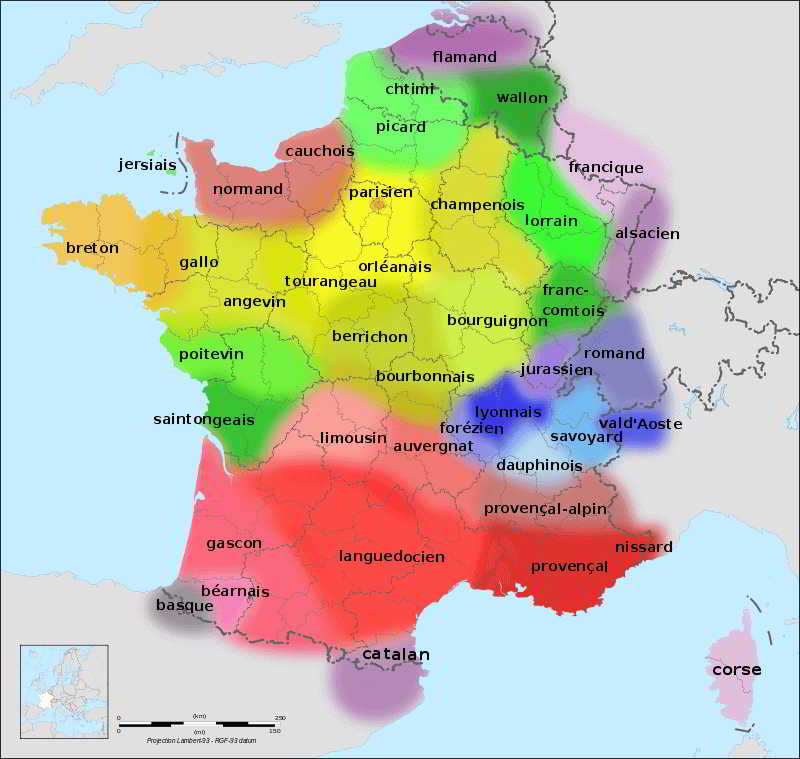
Marseillais has a unique rhythm that can be challenging to follow.
Sadly, like other minor dialects, the media promotes dominating Parisian dialect and rarely covers Marseillais. Yet, it remains an influential cultural aspect of southern France.
(iii) Belgian French
Belgian has three official languages: Dutch, German, and French. The variety of French spoken in the country refers to Belgian French.
The Belgian type shares many similarities with Standard French. Still, it has many distinct wordings, pronunciations, and expression elements.
The version has more nasal vowels compared to Standard French. For example, words like “pain” (bread) may be pronounced with a more nasalized vowel sound.
The pronunciation of certain consonant sounds, like the “r” sound, may deviate. It can be softer or more guttural than in Standard French.
It has many loan words from Flemish (Dutch) and Walloon (a regional Romance language). As a result, some words and phrases may differ from those in France.
Belgian French includes expressions and idiomatic phrases unique to local culture and cuisine. Thus, they are uncommon in Francophone places.
(iv) Swiss French
Switzerland has four official languages: German, French, Italian, and Romansh. French speakers may combine with these languages. The mixing can cause the use of hybrid expressions.
The Swiss and Standard French have likenesses but notable contrasts in pronunciation, vocabulary, and expressions.
Swiss French has a more neutral pronunciation than some regional types in France. It varies in the sounds of vowels than Standard French. Still, it can differ depending on the region within Switzerland.
Swiss French comprises German, Italian, and Romansh words, reflecting the country’s multilingual environment. So, some words and sayings may differ from those helpful in France.
This French dialect has unique terms and idioms related to the culture and institutions of the country. Terms for federalism, political structures, and national symbols can differ from those of France.
Variations may exist between different regions of Switzerland. This is true mainly between French-speaking Romandy and other linguistic areas of the nation.
Overall, it is part of the broader French language family. The unique traits reflect Switzerland’s linguistic and cultural identity.
(v) Luxembourg French
Luxembourg French refers to the kind of French spoken in the Grand Duchy of Luxembourg.
As one of the three official languages of Luxembourg, alongside German and Luxembourgish, French plays a vital role in various aspects of life. This includes education, government, and business.
This variant follows Standard French pronunciation norms, especially Parisian French. The pronunciation may differ slightly because of the influence of Luxembourgish and German.
Like the Swiss variant, this dialect reflects Luxembourg’s culture of multilingualism. The presence of multilingual inhabitants shapes the use and understanding of Luxembourg French.
(vi) Aostan French
Aostan French, also known as Valdôtain or Valdostan French, is spoken in the Aosta Valley. This is in the autonomous region of northwest Italy.
Aostan French is one of the region’s official languages, alongside Italian and the local Franco-Provençal dialect.
The Italian phonology has affected the pronunciation of vowels and consonants. Due to the proximity and historical connections with Italy, some sounds may vary. It also retains more nasal vowel sounds.
The conjugation patterns of Aostan are like those of Standard French. But some irregular or archaic forms may remain. Sometimes, like subordinate clauses or complex sentences, the word order resembles Italian syntax.
Aostan French has developed over centuries in a region influenced by French and Italian cultures. It serves as a local identity and heritage tag. It defines the Aosta Valley region’s linguistic diversity and cultural richness.
2. African French
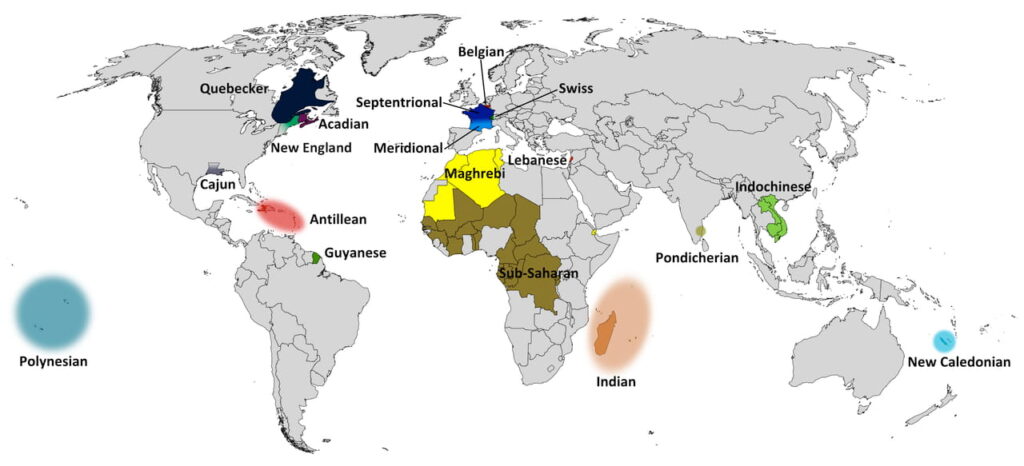
African French refers to the French spoken in various African countries. Due to colonial history, French is an official language in many African nations and is part of Francophone. Millions of people continue to speak it as a second language.
African French exhibits meaningful pronunciation, vocabulary, and grammar diversity. The local languages, cultures, and historical factors have affected the French.
There are lots of phonological variations in the African French. It deviates from Metropolitan in vowel sounds, intonation patterns, and consonant pronunciation.
The nasalization of vowels is more prevalent. It echoes the impact of local African languages where nasal vowels are common.
African French combines words from indigenous African tongues, Arabic, and other colonial languages like English and Portuguese. This leads to a diverse lexicon with unique expressions not in standard French.
The grammar is pretty simple compared to the standard. It has fewer verb conjugation forms and simple sentence structures and uses more direct and concise expressions.
Sub-Saharan lingos have influenced word order, agreement markers, and aspectual characteristics.
African French reflects the cultural diversity of the African continent. It reflects local customs, traditions, and beliefs embedded in everyday speech.
The French of Africa is an always-changing and evolving linguist. It adapts over time, mirroring the African continent’s diverse historical, linguistic, and cultural contexts.
There are several varieties of African French. The four broad variants are:
(i) Beninese / West African French
West African French is helpful in countries such as Senegal, the Ivory Coast, Mali, Benin, and Burkina Faso. It exhibits unique features impacted by the region’s languages and cultures.
Around 40% of the population of Benin spoke French. Fongbe is another common tongue. Hearing both languages mixing, with rare loan words or code-switching, is expected.
Only some academic sources exist surrounding the particularisms of Beninese French. It has adapted the meanings of several French terms over time.
(ii) Kinshasa / Central African French
Congolese (Kinshasa) French is spoken in the Democratic Republic of Congo and neighboring places in Central Africa like Cameroon, Gabon, etc.
Being the largest French-speaking country globally, DRC has developed its unique dialect and slang while using French in business, education, and government.
The language is spoken at a slower pace with a more relaxed articulation. These differences in structure and language make Congolese French a distinct form of the language.
Congolese French is spoken differently from standard French. This dialect uses elongated vowel sounds and highlights tone. It mirrors the linguistic variousness and cultural heritage of Central Africa.
(iii) Algerian / Maghrebi French
Maghreb French, also known as Algerian French, is a dialect of French spoken in North Africa. It is used in Algeria, Morocco, and Tunisia, which were once French colonies.
This version displays influences from Arabic and Berber languages and features cultural references unique to the Maghreb region.
Algeria is the second-largest Francophone nation in the world in terms of French speakers. Many educated people in the region are fluent in both French and Arabic.
The Arabic language and culture have influenced Maghreb French, and it has become an essential part of it. This is more similar to Parisian French than sub-Saharan dialects.
One example of this dialect is the verb kiffer. It means to like and comes from the Arabic word kif, which has the same meaning. Kiffer is common in Parisian slang. It shows how French dialects have spread globally.
(iv) Egyptian / Eastern Africa
French is spoken in Eastern Africa, mainly in Madagascar, Comoros, and Mayotte. As of 2018, there were 5.6 million speakers of French as a first or second language.
French is not an official language in Egypt, but many people learn it. Most Egyptians who speak French do not speak it as their first or second language.
Egyptian Arabic has notably impacted Egyptian French.
Sentences in Egypt differ from the standard. The determinant is often left out or written in Arabic to focus on expressing ideas rather than sentence building. Some compare these contrasts to those of the Creole language.
3. French in North America
Several French dialects are spoken in North America, especially in Canada and the United States.
Each has unique markers affected by geographical, historical, and cultural factors. Here are some of the top French dialects found in North America.
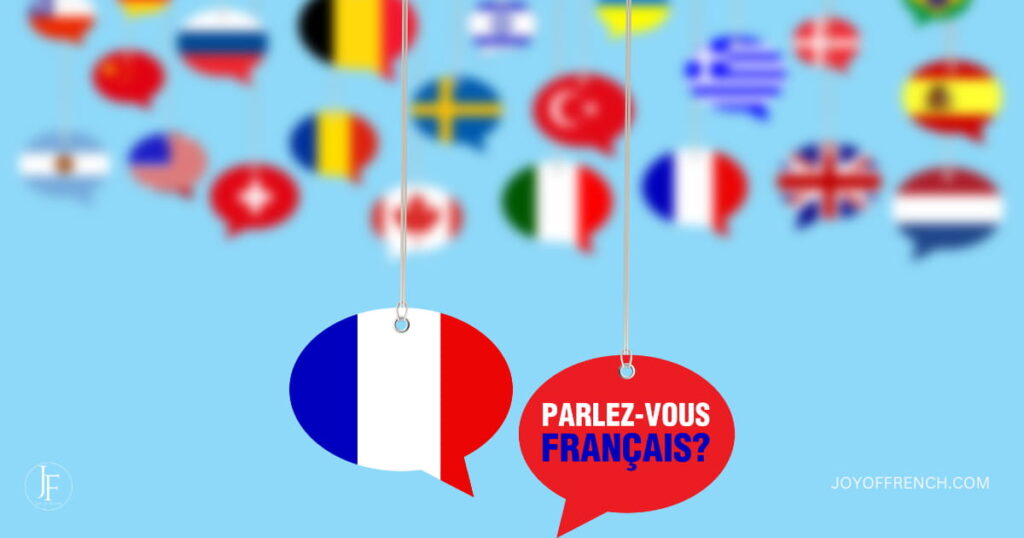
(i) Québécois French
French is one of Canada’s two official languages. But in Quebec’s province, it is the only one.
You even get bonus points if you clear a French test like TEF Canada, TCF Canada, or TEF or TCF Quebec.
Québécois French has distinctive features. It varies in pronunciation, words, and some grammatical structures. The sound includes vowel nasalization and unique intonation patterns.
Quebecois have a distinct way of pronouncing certain consonants, mainly “t” and “d.” When these letters come before “u,” they speak with an “s” or “z” sound.
Quebecois and Parisian French have minor differences in vocabulary. But, the disparities in sound are much more noticeable.
This retains archaic features of French, including the use of the “tu” form of address and the preservation of older French terms. Old French and the English language which has influenced this variant of Quebec.
Joual is a type of French language that working-class neighborhoods of Quebec speak informally.
(ii) Acadian French
Acadian French is spoken in the Acadian regions of Canada. It is helpful mainly in New Brunswick and certain parts of Nova Scotia, Prince Edward Island, and Maine, USA.
It has distinct attributes that set it apart from other French dialects. The sounds are unique, with deviations in vowels and consonant pronunciation.
Acadian French speakers may use specific expressions and vocabulary not typically followed in other dialects. It has a strong focus on maritime and rural themes.
There is also Chiac, which is Creole — A blend of English and French. This differs from Acadian French and is often considered a form of Franglais.
(iii) New England French
New England French is a type of French spoken in the New England area of the USA. It comes from Canadian French because it came from French Canadians who relocated to New England during the Grande Hémorragie.
This French integrates vocabulary from Quebecois French, with some influence from English. It has unique terms and expressions not found in Standard French.
Many descendants of French-Canadian immigrants no longer speak French fluently. This led to a decrease in the number of speakers of New England French. Despite its decline, it keeps cultural importance to some extent.
(iv) Louisiana French
They are spoken in the USA state of Louisiana, particularly in areas such as Cajun Country (Acadiana) and New Orleans. Communities with French heritage use this variant, which has grown.
Pronunciation has distinct vowel sounds and intonation patterns, with some features like Acadian French. It has unique words and phrases, influenced by Louisiana’s multicultural heritage and Creole influences.
There is also a Louisiana Creole, which varies from Louisiana French. It mixes French, Spanish, African languages, Spanish, and Native American Indigenous languages.
People often use language labels to refer to ethnic groups. E.g., Cajun might call their language “Cajun French,” even when it is Louisiana Creole. Not all Creoles speak Louisiana Creole; some talk to Louisiana French.
(v) Missouri French
Historically, the Missouri River and former French colonies in the Midwest US spoke this language.
Midwest French is a unique French language. It has been influenced by English and Indigenous languages, developed from the French spoken by early settlers in the region.
Pronunciation differs from other dialects, with riffs in vowel sounds and intonation affected by regional English dialects. There is a decline in use. Still, it is preserved in some communities and cultural traditions.
4. Other French dialects
There are 100 French varieties, creoles, and even altogether a different language that is considered close to this language.
There are many dialects. For instance, Newfoundland, Lebanese, Indian, Lao, Abidjan/Ivorian, Cambodian, and Vietnamese, to name a few.
5. French-based Creole languages
French-based Creole is a language that has evolved from a mixture of French and other languages. It was often due to colonial contact and the enslavement of African peoples in the Caribbean, Indian Ocean, and other regions.
These languages were developed to interact among diverse populations with different linguistic backgrounds.
Here are some prominent French-based creole languages.
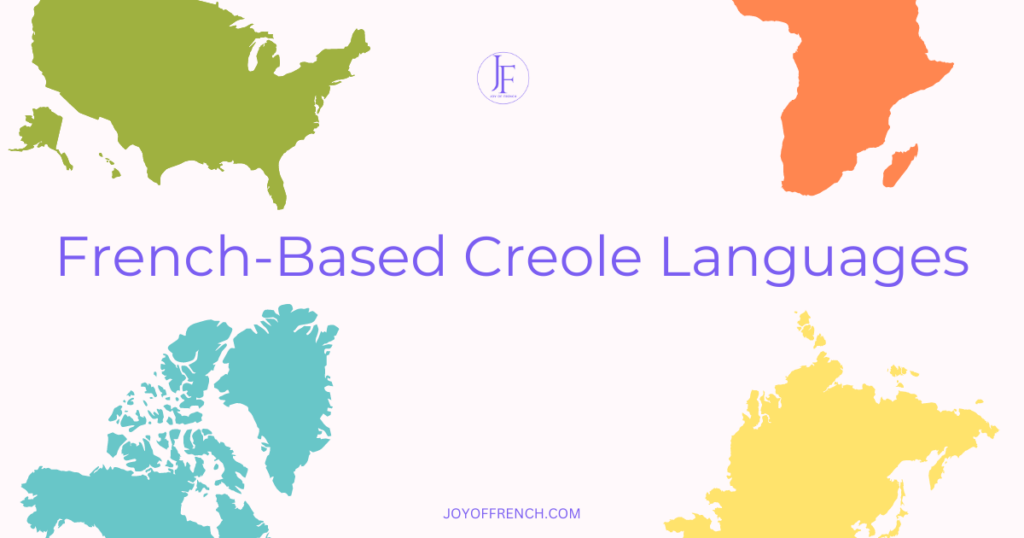
(i) Haitian Creole
Spoken primarily in Haiti but also by Haitian diaspora groups globally. This French variety resulted in a blend of French, West African, and Caribbean indigenous languages.
It has a simplified grammar compared to French. It follows a different phonological system and word impacted by African and local tongues.
A point to remember is that Haitian Creole is distinct from Haitian French. This is often considered a separate language.
(ii) Mauritian Creole
The one is widespread in Mauritius, an island nation in the Indian Ocean.
It is a mix of French, Malagasy, African languages, Indian languages, and English. This reflects Mauritius’s diverse ethnic and linguistic roots, with vocabulary and grammar influenced by various languages.
Mauritian Creole is spoken as a mother tongue and lingua franca in Mauritius, alongside French and English.
(iii) Seychellois Creole
This is spoken in the Seychelles, an archipelago nation in the Indian Ocean.
This mixture of French, Malagasy, African languages, Indian languages, and English. It features a distinct phonological system, grammar, and vocabulary influenced by the diverse ethnic groups in Seychelles.
This is also across the board in the Seychelles alongside French and English.
(iv) Antillean Creole
This is the French type of the Caribbean islands, including Martinique, Guadeloupe, and Saint Lucia. Martinique and Guadeloupe recognize it as an official language alongside French.
This unique language is formed by combining French, African languages, and Indigenous Caribbean languages. Other cultural influences also impacted it.
This language is characterized by its grammar rules, words, accents, and pronunciation. It reflects the history and culture of the Caribbean islands.
(v) Réunion Creole
Réunion Creole, also known as Réunionnais or Kréol Réyoné, is a language of the island of Réunion. This is a French overseas department located in the Indian Ocean.
This Creole has evolved from a blend of French, African, Malagasy, Tamil, and other languages brought by immigrants to the island over centuries.
It often features nasalized vowels and elided consonants, influenced by French and Malagasy phonology. It has easy grammar, fewer verb conjugations, noun declensions, and syntactic rules.
Réunion Creole is widely spoken as a mother tongue and lingua franca alongside French among the diverse population of Réunion.
(vi) French Guianese Creole
French Guianese Creole, or Guianese Creole or Patwa, is a French-based Creole. This is spoken in French Guiana, a department of France located on the northeastern coast of South America.
French Guianese Creole has developed from a mixture of French, African, and Indigenous languages. There have been influences over centuries.
It has a lexicon influenced by French, African, local languages of the region (such as Arawak and Wayana), etc.
It has words borrowed from other languages, translations of phrases, and changes in the meaning of words from those languages. This has resulted in a diverse vocabulary with many exciting and unique words.
Final Words on French Dialects and Creoles
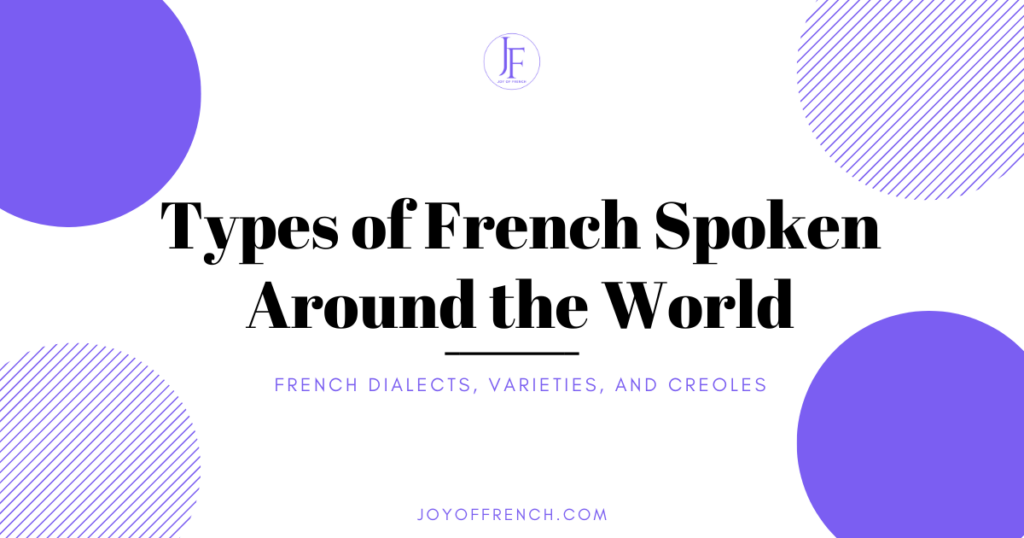
French regional dialects are diverse and always offer something new to explore. These varieties and creoles show the linguistic diversity of the French language and how it has developed in different regions.
They vary worldwide, but you can have basic conversational French skills without much problem. Keep an open mind to local dialects’ vocabulary, sentence structure, and sound differences and nuances.
It’s important to note that Standard French remains the common form used in official and formal contexts. It’s also the one you’ll most likely come across as a French learner in your study materials.
Exposing yourself to an array of spoken French can be helpful to increase your chances of comprehending whoever you may be talking with. You can improve your ability to understand what is being said.
If you intend to learn French, check out our various lessons for diverse purposes and levels. We have both offline and online classes for French. We have French courses for TCF, TEF, DELF, and DALF.
